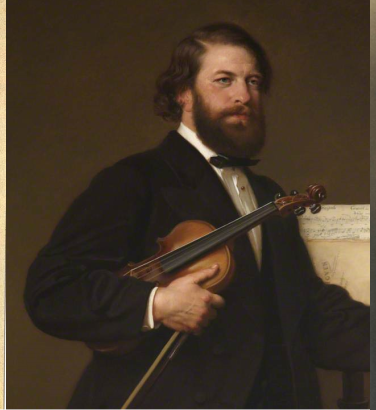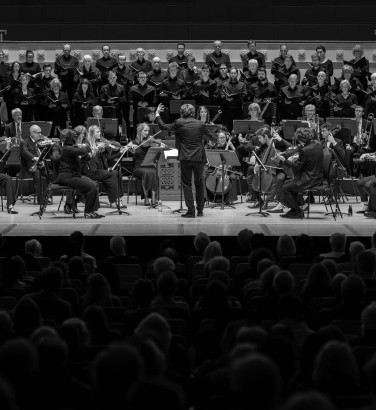
The trumpet concerto
23 Dec 2024
News Story
SCO Principal Trumpet Peter Franks (credit: Christopher Bowen)
This article is part of an ongoing series this Season focusing on the concerto as written for specific instruments in the orchestra. With contributions from SCO players, we hope these give you some new insight into works you know and an idea of others they would recommend seeking out.
It's not very often you'd draw a comparison between the flute and trumpet, but the peaks and troughs experienced by both instruments in the number of concertos written for them since the advent of the genre have followed a very similar pattern: plenty in the Baroque era, then just about nothing until the middle of last century.
Other commitments have unfortunately prevented the SCO Trumpeters – Principal Peter Franks and Sub-Principal Shaun Harrold – from contributing to this article, but they have provided us with important pointers, so what follows comes with their seal of approval.
After moving into courtly life from the battlefield, the trumpet provided a celebratory flourish as part of instrumental ensembles during the Renaissance era and even more so as part of a larger Baroque orchestra. Its popularity at this time is even more remarkable for the fact that none of the great composers of the period wrote any concertos for the instrument. This is not to say, however, that the likes of Bach and Handel didn’t appreciate its sound: the latter unsurprisingly put the trumpet in the spotlight in the bass aria ‘The trumpet shall sound’ in Messiah, while some of Bach’s most exuberant scores – his Orchestral Suites Nos 3 and 4 among them, along with the B Minor Mass – include three trumpet parts, a vital part of their music’s jubilatory mood.
Among their lesser-known contemporaries, we find solo concertos by Graupner, Hertel and Molter; the last of these is known to have written at least three, not to mention five for a pair of trumpets. These, like their equivalents by Vivaldi and Manfredini, capitalise on these declamatory instruments’ use in fanfares: if they’re not playing in duet, they will often echo one another. (Note that the 1950s saw a plethora of Baroque concertos being transcribed for trumpet, and not always very accurately at that. The concertos mentioned here are, however, all genuine.)
Listening to any of this music, it is immediately obvious how much the instrument’s brilliant high register was appreciated. Like all brass instruments of the period, the trumpet was essentially a coiled tube, so it took a highly skilled performer to produce any more than a limited number of notes from it. While horn players could, to an extent, modify pitches according to how they placed their hand inside the bell of the instrument, trumpeters had to rely on the subtle modification of their embouchure alone, i.e. the precise positioning of their lips against the mouthpiece.
It is no exaggeration to say that the virtuosos of the period were highly prized as a result. Many of Handel’s most challenging trumpet parts were written for Valentine Snow, whose own works added to the instrument’s fashionable status in Georgian England. There is enough of this repertoire for the occasional release of albums devoted to the English trumpet concerto of the period, that by Mudge being a frequent inclusion – though today, none of them can compete with Jeremiah Clarke’s The Prince of Denmark’s March in terms of recognisability.
The stripping back of Baroque grandeur and intricate lines seems to have sounded the death knell for the trumpet’s heyday, there being no place for such extravagance in music which prized elegance above all - except for those occasions in need of a festive note, when a pair of trumpets generally came in tandem with the timpani. Its use as a solo instrument became increasingly rare, though Leopold Mozart did contribute a late addition to the genre in 1762. It was not until the invention of a new model of trumpet, three decades later, that we find the next important concerto for the instrument.

Played using keys placed over holes (much like the modern saxophone), this creation by the Austrian Anton Weidinger quickly benefitted from a concerto by Haydn, which explored its extensive low and middle ranges – notes which just weren’t available on the Baroque trumpet. Hummel’s concerto, written less than a decade later (also for Weidinger) is definitely less known today, and has been superceded even more since the dystopian thriller Squid Game (the second series of which has just been released) adopted the perky finale of Haydn's concerto as (of all things) an alarm call which grows increasingly ominous every time it is heard.
It's almost as unlikely as the inclusion of Amilcare Ponchielli – something of a one-hit wonder thanks to Dance of the Hours – on a list of trumpet concertos, but that’s an indication of their paucity in the 19th century: besides another by Oskar Böhme, himself a trumpeter, it really is slim pickings. This may be down to the design of the instrument being anything but standardised until well into last century, despite the first valved trumpets appearing in the 1830s. To this day, concertos tend to be written with specific soloists in mind, each with their own preferred type of trumpet – as a result of which the music isn’t systematically playable on a different model.
It’s just as well the instrument had gained a secure place in the orchestra, where a larger brass section now came as standard. Wagner was among those to exploit its sound to the fullest, while over in Russia, Tchaikovsky’s Symphony No 4 is haunted by a fanfare figure that constantly threatens to derail proceedings. Try as it might, however, the trumpet’s military origins had become inescapable by this stage: the Day of Judgement in Verdi's Requiem is depicted with fanfares from eight of them, a sign of how much the orchestra had grown since the days of Handel’s Messiah. Add a tinge of horror to the sound and you get the devastating 'Mars, Bringer of War' that opens Holst’s suite The Planets.
Some composers countered this trend, seeking out new ways to write for the trumpet. The French were especially skilled in this regard: in his orchestration of Mussorgsky’s Pictures at an Exhibition, for instance, Ravel muted the instrument, transforming its usually bold sound into a thin, unsteady trail for the movement depicting ‘Samuel Goldenberg and Schmuÿle’. Shostakovich’s satirical Piano Concerto No 1 is sometimes known as Concerto for Piano, Trumpet and Strings in recognition of the trumpet’s soloistic role – and Prokofiev used three of them in playful mode amid the tragedy of Romeo and Juliet, in a 'Dance with Mandolins'.
Nor should we overlook the importance of the trumpet in jazz. Gershwin had given it an important solo part in the slow movement of his Piano Concerto (heavily influenced by blues), long before the rise of such household names as Louis Armstrong, Chet Baker, Miles Davis, Dizzy Gillespie … and I’m Sorry I Haven’t a Clue’s longtime host Humphrey Lyttelton.
Back in the classical sphere, the second half of the 20th century brought with it such an explosion of solo trumpet repertoire that (again like the flute) there has been at least one major new trumpet concerto in every decade of the postwar period. This has included a small but significant number by female composers such as Tailleferre (the one woman in Les Six), Vaughan Williams’ pupil Grace Williams and, bringing us closer to home, Thea Musgrave, Sally Beamish and Helen Grime. There has also been an impressive amount of music written for unaccompanied trumpet, either heavily inspired by the instrument's role at the centre of Remembrance Day ceremonies ... or deliberately subverting these expectations, such as in Maxwell Davies' Litany – for a Ruined Chapel between Sheep and Shore or Turnage's An Aria With Dancing.
As for why it has taken so long for the trumpet concerto to establish itself, the answer is unclear. The instrument itself has, however, been embraced by American composers, for whom it has come to represent a nobility of spirit. This is certainly true when it comes to the film music of John Williams: think of the majesty of the Superman theme, or the dignity of the one he wrote for Jurassic Park. Other composers have used the trumpet concerto to reflect on other aspects of American culture, as evidenced by the titles of Steve Heitzeg’s American Nomads or John Mackey’s Antique Violences. We might think this is all a recent phenomenon, but America’s identification with the trumpet goes at least as far back as Ives’ The Unanswered Question, written in 1908.
No matter how precarious the trumpet’s status as a solo instrument has been over the years, there is no doubt that it is now well established as such, helped by the efforts of distinguished trumpeters from Maurice André to Håkan Hardenberger and Alison Balsom. When Sergei Nakariakov joins the Orchestra to perform Jörg Widmann’s deliriously virtuosic ad absurdum (30 – 31 January), you may find yourself wondering if we have entered a new golden age of the trumpet concerto.

Ad Absurdum
Jörg Widmann's whirlwind of a trumpet concerto from Sergei Nakariakov forms the centrepiece of a concert to raise a laugh.
Related Stories
![A violinist shown at three different ages: as a young man in a drawing, middle-aged in a painting and elderly in an old photo]()
Joseph Joachim and the great German violin concertos
7 April 2025
Beethoven, Mendelssohn, Bruch and Brahms: four violin concertos, all connected by a single violinist.![Three men, the first two in 18th century formal dress (one in black and white, one in a red coat), the last in an old photo, smoking]()
What is a sinfonia concertante?
17 March 2025
We delve into the history of a hybrid genre ...![]()
The SCO Chorus on music for Lent
10 March 2025
With Easter just around the corner, we delve into perhaps the richest (and often darkest) choral repertoire of all ...


